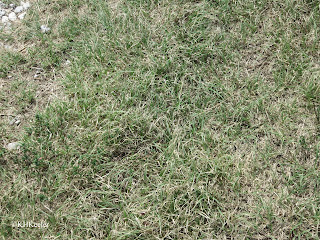 |
| stand of buffalo grass, Buchloë dactyloides, grass family, Poaceae. Area is about 1 square yard. |
 |
| herd of bison (old bad photo) |
 |
| buffalo grass, Buchloë dactyloides, closer view, area less than 1 square foot. The grass blades are about 4" tall. |
(I have no idea why there are dots, an umlaut, over the e. There are two syllables there, though: Buk lo ee).
The "buffalo" in the name of the buffalo grass refers to the American bison, Bison bison, popularly called the buffalo. Buffalo grass, Buchloë dactyloides, apparently owes its distribution to the bison. And it contributed to the bison's success. In sum, they have a mutualistic relationship aiding both, even though they are grass and grazer.
 |
| buffalo grass, Buchlöe dactyloides spreading on dry ground |
Why is it so much more widespread than its relatives? Probably because bison like to eat buffalo grass. As a food for bison and cattle, it is hard to beat buffalo grass. Buffalo grass is nutritious. Furthermore, it is nutritious wet or dry, fresh or frozen. Other prairie grasses store any nutrients they have accumulated during the year in their roots over the winter, so the late fall and winter prairie hay is really straw, with little food value for animals. Buffalo grass keeps the nutrients in the leaves. If a bison digs down through a foot of snow to find buffalo grass, it gets a good meal.
 |
| buffalo grass, seed capsules |
Jim Quinn of Rutgers demonstrated experimentally that buffalo grass seeds germinate much better after being eaten by bison.
 |
| buffalo, American bison, Bison bison |
Feeding the bison and being transported by them has made Buchloë dactyloides one of the dominant plants of North American grasslands.
(You can find buffalo grass as Buchloë dactyloides and Bouteloua dactyloides. Same plant. The systematists don't agree. I'll explain what's going on in another post. Until the experts sort it out, both names are okay.)
Comments and corrections welcome.
References
Quinn, J. A., D. P. Mowrey, S. M. Emanuele and Ralph D. B. Whalley. 1994. The "foliage is the fruit" hypothesis: Buchloe dactyloides (Poaceae) and the shortgrass prairie of North America. American Journal of Botany 81(12): 1545-1554. (source of the details of the buffalo grass- bison mutualism)
Weaver, J.E. Prairie plants and their environment. A fifty-year study in the midwest. University of Nebraska Press, Lincoln.
Bad link removed 1/30/21.
Weaver, J.E. Prairie plants and their environment. A fifty-year study in the midwest. University of Nebraska Press, Lincoln.
Bad link removed 1/30/21.
Is this the same (or similar) buffalo grass that's used as a xeric lawn? I've always wanted that stuff...
ReplyDeleteYes! It is widely planted as a water-efficient lawn grass. I was just thinking I should have said that. Thank you!!!
Delete